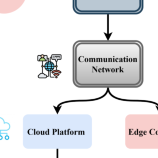
Arvind R. Singh
Writer at Nature
A deep learning and IoT-driven framework for real-time adaptive resource allocation and grid optimization in smart energy systems. Source
Articles
-
Dec 30, 2024 |
nature.com | R. Siva Kumar |Faisal Alsaif |Mohit Bajaj |Ievgen Zaitsev |K. Reddy Madhavi |Arvind R. Singh
The integration of Electric Vehicles (EVs) into power grids introduces several critical challenges, such as limited scalability, inefficiencies in real-time demand management, and significant data privacy and security vulnerabilities within centralized architectures. Furthermore, the increasing demand for decentralized systems necessitates robust solutions to handle the growing volume of EVs while ensuring grid stability and optimizing energy utilization. To address these challenges, this paper presents the Demand Response and Load Balancing using Artificial intelligence (DR-LB-AI) framework. The proposed framework leverages Artificial intelligence (AI) for predictive demand forecasting and dynamic load distribution, enabling real-time optimization of EV charging infrastructure. Furthermore, Blockchain technology is employed to facilitate decentralized, secure communication, ensuring tamper-proof energy transactions while enhancing transparency and trust among stakeholders. The DR-LB-AI framework significantly enhances energy distribution efficiency, reducing grid overload during peak periods by 20%. Through advanced demand forecasting and autonomous load adjustments, the system improves grid stability and optimizes overall energy utilization. Blockchain integration further strengthens security and privacy, delivering a 97.71% improvement in data protection via its decentralized framework. Additionally, the system achieves a 98.43% scalability improvement, effectively managing the growing volume of EVs, and boosts transparency and trust by 96.24% through the use of immutable transaction records. Overall, the findings demonstrate that DR-LB-AI not only mitigates peak demand stress but also accelerates response times for Load Balancing, contributing to a more resilient, scalable, and sustainable EV charging infrastructure. These advancements are critical to the long-term viability of smart grids and the continued expansion of electric mobility.
-
Aug 6, 2024 |
nature.com | K. G. Suresh |B. N. Kumar |Mohit Bajaj |E. Parimalasundar |Milkias Berhanu Tuka |Arvind R. Singh
This research paper introduces an avant-garde poly-input DC–DC converter (PIDC) meticulously engineered for cutting-edge energy storage and electric vehicle (EV) applications. The pioneering converter synergizes two primary power sources—solar energy and fuel cells—with an auxiliary backup source, an energy storage device battery (ESDB). The PIDC showcases a remarkable enhancement in conversion efficiency, achieving up to 96% compared to the conventional 85–90% efficiency of traditional converters. This substantial improvement is attained through an advanced control strategy, rigorously validated via MATLAB/Simulink simulations and real-time experimentation on a 100 W test bench model. Simulation results reveal that the PIDC sustains stable operation and superior efficiency across diverse load conditions, with a peak efficiency of 96% when the ESDB is disengaged and an efficiency spectrum of 91–95% during battery charging and discharging phases. Additionally, the integration of solar power curtails dependence on fuel cells by up to 40%, thereby augmenting overall system efficiency and sustainability. The PIDC’s adaptability and enhanced performance render it highly suitable for a wide array of applications, including poly-input DC–DC conversion, energy storage management, and EV power systems. This innovative paradigm in power conversion and management is poised to significantly elevate the efficiency and reliability of energy storage and utilization in contemporary electric vehicles and renewable energy infrastructures.
Try JournoFinder For Free
Search and contact over 1M+ journalist profiles, browse 100M+ articles, and unlock powerful PR tools.
Start Your 7-Day Free Trial →